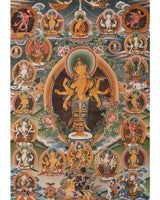
Amoghpasa Thangka | Tibetan Buddhist Handpainted Art | Wall Decor

100% AUTHENTIC

HANDMADE

FREE SHIPPING
Amoghpasa Thangka
About Our Thangka :
This beautiful piece of art is over 25 years old (The Early 1900s). Although there is no mention of the artist’s actual name, the skillful detailing, uniform brush strokes, and unique composition show the mark of an expert artist. Its exceptional quality comes from the masterful artistry that is present here. We acquired the painting from the possession of a Japanese collector about ten years ago (August 2014). However, we know little else about the origins of the said painting except for the date of its creation.
In the thangka painting, you can see that the artist has given it their personal touch, which makes it so distinctive.The size of the painting, what kind of materials have been used, color coding, and others
Introduction of Amoghpasa :
Amogpasha Lokeshvara, also known as the “Unfailing Noose Lord of the world,” is one of the many forms of Avalokiteshvara. In Indic Buddhism, Avalokiteshvara is a fully enlightened Bodhisattva. Avalokiteshvara will stray away from their path of Parinirvana (final cessation) until all sentient beings are safe. Avalokiteshvara can assume any form, be it human or non-human.
As a deity, Amogpasha is an embodiment of altruistic (selfless) compassion. In Buddhist scriptures, he is the embodiment of Dharnis or mantras (Sanskrit prayers whose repetition is said to strengthen religious belief and facilitate attainment).
According to the Amoghapasa Dharani Sutra, “Amoghapasa is the secret, wise ruler of everything in this world. A practitioner who has received the teachings of this mantra will be able to recite all the mantras and completely perform all deeds.” The repeated recitation of the mantras from his scriptures promises the attainment of spiritual and material benefits.
Amoghapasha in the painting appears in princely attire, adorned in rich jewelry. On his head is a gold crown with the image of Amitabha Buddha, his progenitor. The eight armed Amoghapasha holds a flask (Kundika) on his principal left hand while his principal right hand is in Abhaya Mudra, signifying protection, peace and elimination of fear.
On his top left hand Amoghapasha holds a scripture and on the right hand he holds recitation beads (mala). The scripture signifies that he imparts wisdom to devotees so that they can attain liberation from cyclic existence while recitation beads signifies that he imparts wisdom to devotees.
Appearance
Appears six armed with princely colorful attire,seven colors of rainbow. Wearing rich jewelry, elaborate hair arrangement with crown. Image of amitabha buddha on his crown (his progenitor)Principal hands, in right hand a gesture of bestowal with palm facing upwards (showing compassion). In left hand a stalk of lotus, the lotus flower appears above shouldersUpper two hands: one hold recitation bead and other holds a scripture. Middle hands : One holding trident one holding adamantine noose (Vajra Pasa) after which the god gets his name.Third pair of hands: flask or kundika
Aura of radiance
Scripture: Signifies that he imparts wisdom to devotees and they thereby attain liberation from cyclic existence
Holding a lotus: signifies that he liberates the sentient beings residing in the hell relms from the suffering of intence heat (usna) and cold (sita) just like a lotus which emerges from muddy water perfectly unfamished
Amogapasa: symbolizes that he had infallible skill in means for converting ignorant sentient beings into the path of liberation
Holding a water pot: signifies that he has the capacity of empowering and leading all sentient beings into buddhahood
Abhayamudra: Symbolizes that one who practices the astamivarta sincerely is protected from falling into lower realms
A string of beads/rosary: signifies that by the recitation of the six-syllable mantra of avalokitesvara, one frees oneself from the bondage of samsara
Holding a trident: Signifies that he purifies the three poisons of sentient beings i.e. lust, ill will and stupidity
Gesture of Varada Mudra : Signifies that those who practice and generate compassion and bodhichitta receive all desired things
------------------------------------------------------------------
Size: 11"/ 28 cm (width) x 15"/ 38 cm (height)
Materials: Cotton Canvas, Acrylic Colors, Genuine 24K Gold
------------------------------------------------------------------
THIS THANGKA IS HAND-PAINTED IN THE TRADITIONAL STYLE AND THE QUALITY IS HIGH
How Does Amoghpasa mantra benefit ?
These benefits include spiritual benefactions like supernatural power, skill in religious practice and the six perfections of Bodhisattva practice, understanding Buddhist teaching, and release from primary and secondary causes of suffering. Material benefits include immortality, happiness, wealth, cure for all diseases, control over the weather, and overcoming disasters.
Shipping & Returns
We ship worldwide. Orders dispatch in 2–3 business days. International delivery typically arrives in 4–10 business days via DHL Express, depending on destination and carrier conditions. All items ship free globally.
Returns are accepted within 14 days of delivery. Products must be returned in original condition for a refund to be issued once received and inspected. Terms and conditions apply.











